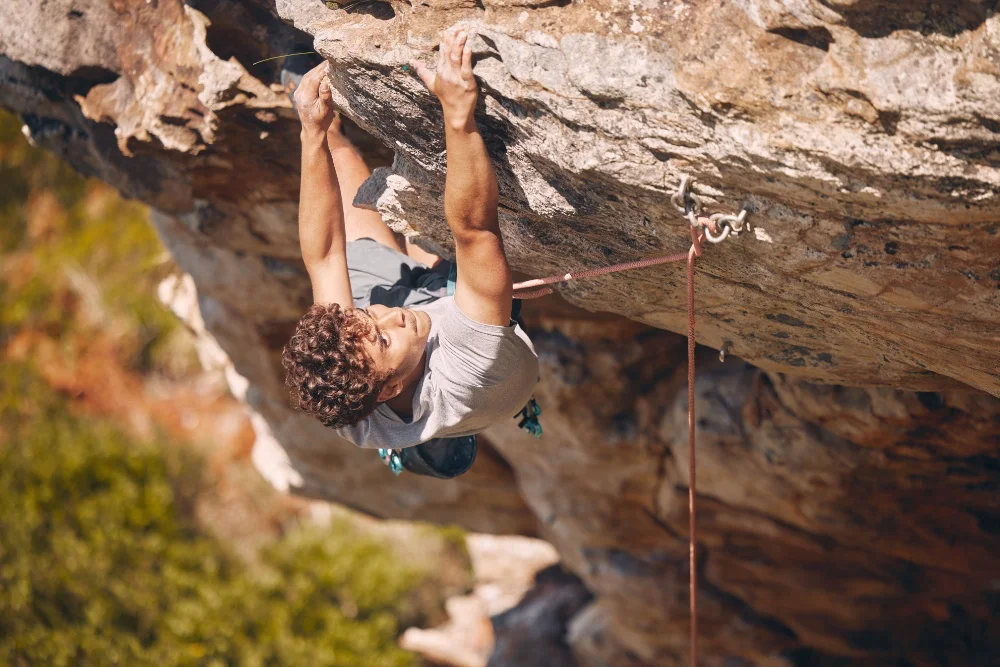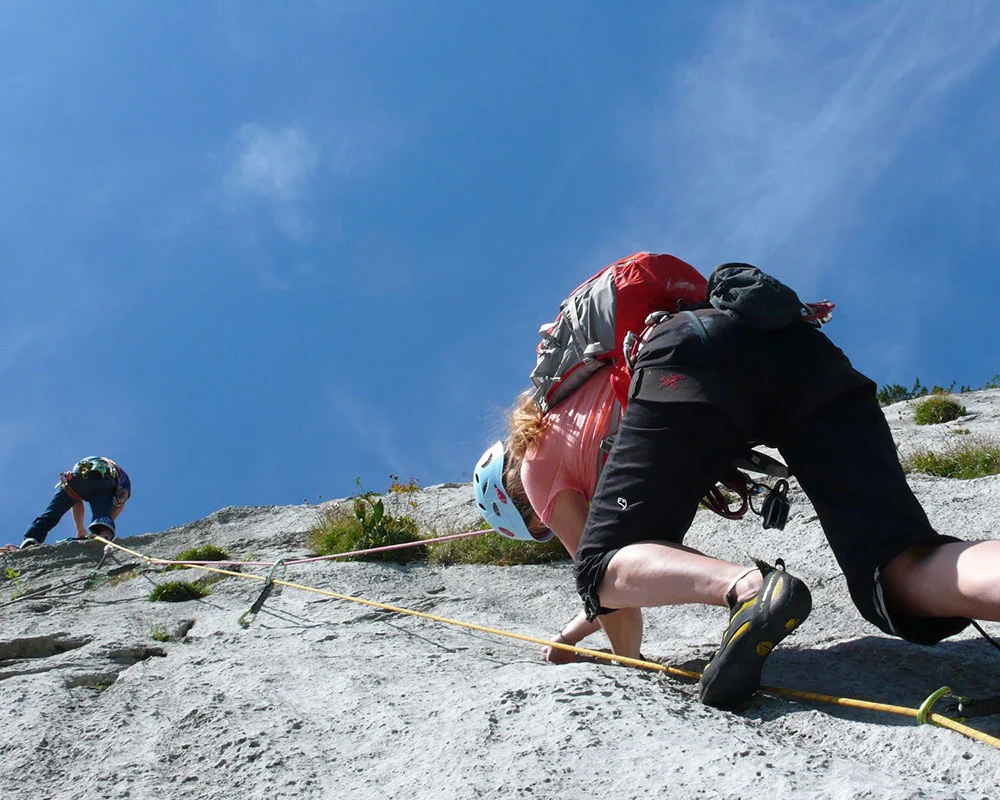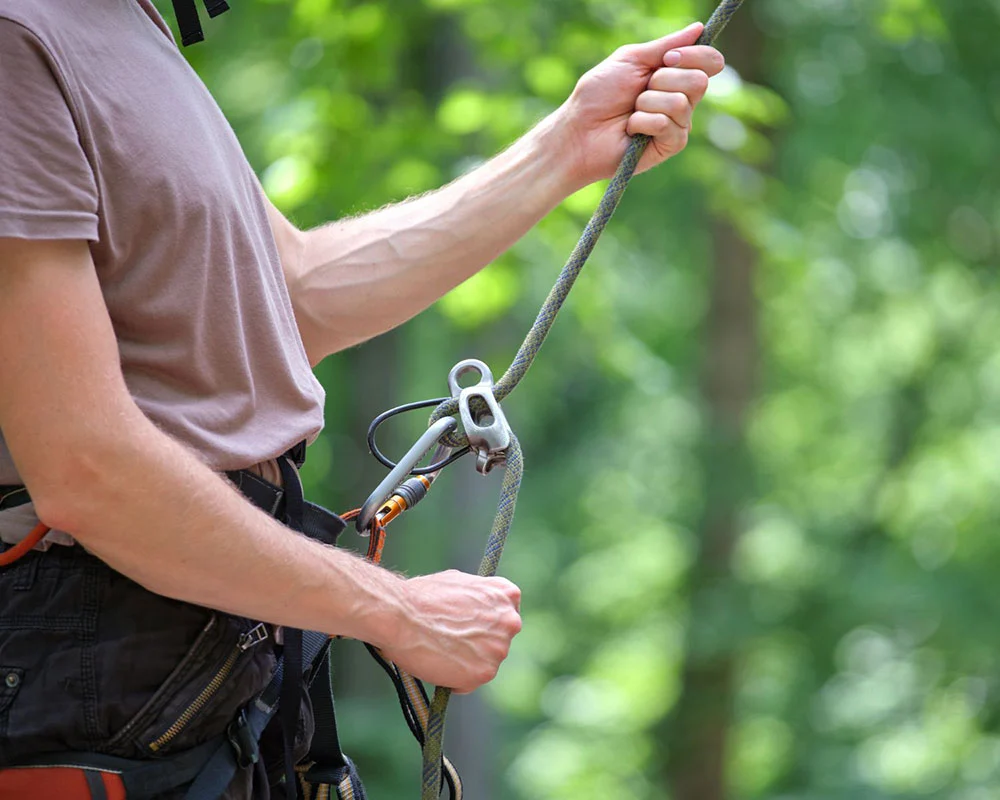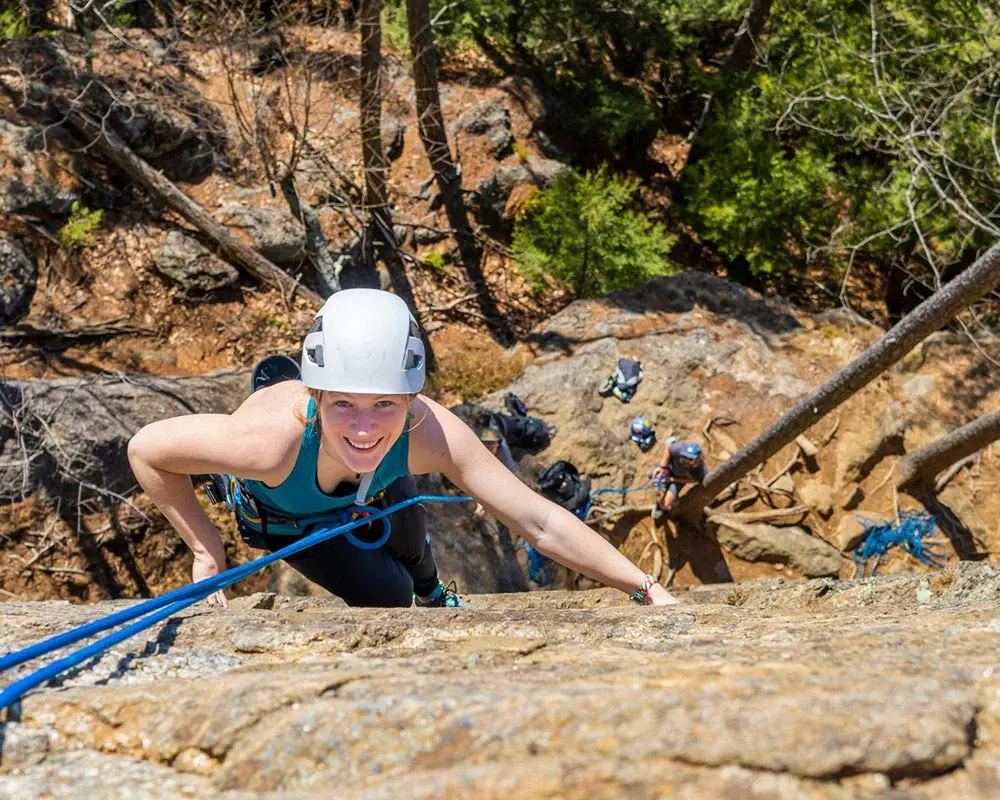If you are interested in learning about rock climbing or want to start climbing yourself, you first need to learn essential rock climbing terms.
This is a basic requirement for understanding explanations of climbing techniques and gear that you’ll need. Knowing the meanings of basic rock climbing terms like “bouldering” and “top-roping” will help beginners start their adventure at the gym and then outdoors.
In this article, we’ll cover the basic rock climbing terms that beginners should know.
Let’s get started!
Rock Climbing Gear
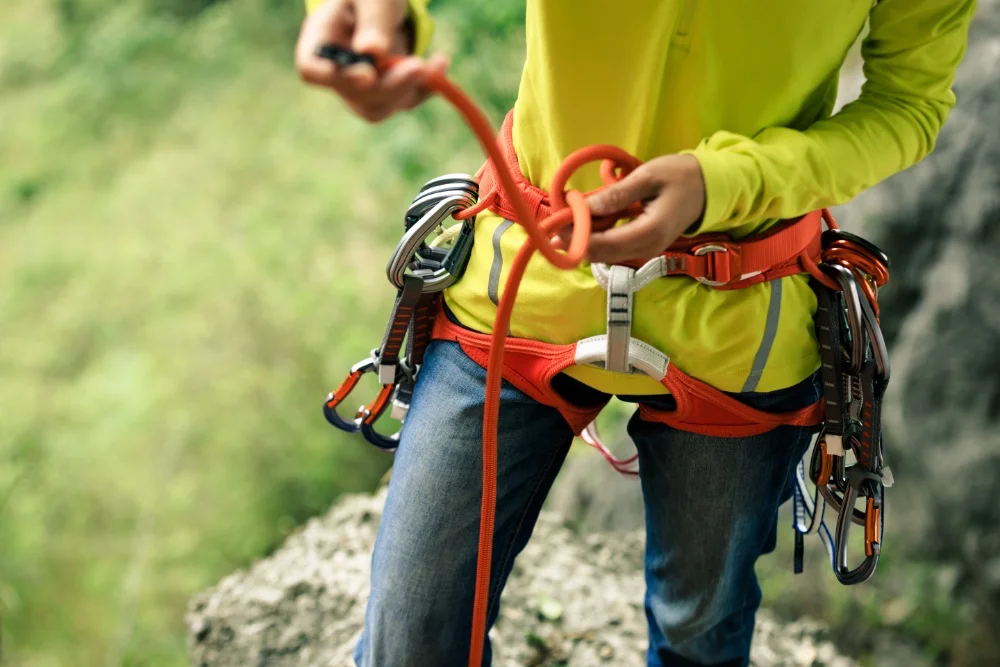
1. Climbing Anchors
Climbing Anchors are an essential type of safety equipment. The climbers clip their ropes to the Anchors to secure them on the route and stop them from falling.
Different materials can be used to create a climbing anchor. These include man-made materials and natural elements like trees and rocks. Man-made climbing anchors include bolts, hangers, quickdraws, and/or slings as well as spring-loaded and camming devices.
Two types of Climbing Anchors exist: fixed and traditional.
Fixed Anchors are already in place with bolts and hangers which is perfect for beginning climbers. Traditional Anchors are placed by the climber with cams or passive nuts.
Uses for Climbing Anchors
- Spring-loaded camming devices, also known as ‘cams’. These are great for horizontal cracks. To use a spring-loaded camming device, first select the appropriate size for the crack or crevice you will be placing it in. Next, insert the device into the crack and use the trigger to expand the device until it is securely in place. Finally, clip your rope into the loop at the end of the device to provide protection as you climb.
- Nuts – a small, wedge-shaped piece of metal or other material used for protection on a rock climb. Nuts are passive devices that can be forcefully wedged into cracks or crevices in the rock and clipped to the climber’s rope with a quickdraw to provide protection in the event of a fall.
👉 Pro Tip It's important to keep in mind that Anchors can fail. Climbers should double-check placement and make sure they are safely attached. In case of a fall, the Anchor must be able to handle the weight and force of the climber.
2. Belaying
Belaying is the method used with partner climbing. The leader ascends first and sets anchors for the climbing rope which helps the second climber ascend. Spring-loaded camming devices are a common type of anchor used to secure the rope.
3. Belay Device
This is a piece of equipment used by the climber’s partner to manage the rope as the climber ascends or descends a climb. Belay devices can be manual or assisted, but they are all designed to allow the belayer to control the rope easily and safely.
4. Belay glasses
These are special glasses with mirrors, so you can see what’s happening above without straining your neck and they’re spring-loaded. So they won’t slip off when you move.
👉 Pro Tip When wearing belay glasses, check the climber visually too. To make sure they're safe and secure.
5. Carabiners
Carabiners are spring-loaded metal clips used to secure ropes, harnesses, and other climbing gear. There are two basic types:
There are several types of carabiners. Locking carabiners have a gate that can be locked to stop it from accidentally opening. Non-locking carabiners are simpler to use but less secure.
Correctly using a carabiner is key for safe climbing. Know the types – screwgate, wiregate, autolocking – and how to operate them. Misuse can weaken the carabiners and lead to dangerous consequences. Straight gate carabiners are suitable for the rope end of quickdraws. Bent gate carabiners should be used to clip the rope while leading.
👉 Pro Tip Check carabiners and other gear for wear and tear before use. Secure the carabiner properly, and never overload it.
6. Chalk
Chalk is a must-have for rock climbers. Chalk refers to a white powder used by climbers to help them grip the rock better and avoid slipping. It’s applied to the hands to absorb sweat and decrease friction.
Rock climbing takes effort and can be hard on the hands and fingers, so it’s critical to have a good hold. It’s especially important for beginners to know about chalk and how to use it when attempting challenging routes or climbing in humid weather.
Chalk can be bought in either blocks or powder form. To make application easier, climbers can attach a chalk bag with a spring-loaded ball to their harness This keeps the chalk from spilling or breaking and helps climbers descend safely.
👉 Pro Tip Don't leave a chalky mess for climbers following you. Too much chalk can make the rock slippery and ruin the experience for others. When you are done, brush off any excess chalk to preserve the natural beauty of the rock.
[convertkit form=5027836]
7. Harness
A harness is essential for both safety and comfort when rock climbing. It is made up of webbing, buckles, and straps that fit around your waist and legs and attach to the rope. Investing in a great-quality harness that fits is key for successful rock climbing.
There are many types of harnesses. Some have a spring-loaded feature for quick attachment and detachment. Others are designed for longer climbs and provide more comfort and support.
👉 Pro Tip Don't go cheap on your harness. Get one that is high quality and fits comfortably. Choose a harness that is adjustable around your waist and legs with extra padding for protection. Features such as spring-loaded gear loops and a belay loop make it easier to clip gear and ensure a safe descent.
8. Climbing Helmet
This is the most essential of all rock climbing gear.
Never climb without a helmet.
This applies to all climbers, regardless of experience level.
Climbing helmets are made of strong materials, like polycarbonate and ABS plastic, with foam padding for shock absorption. There are a variety of styles. Look for features like a lightweight design, vents for breathability, adjustable straps for a secure fit, and a chin strap for stability. Spring-loaded suspension systems are popular, as they provide a more comfortable fit and better protection.
When buying a climbing helmet, make sure it’s certified by governing safety organizations like the UIAA or ASTM. Choose a helmet that fits comfortably and securely on your head. Try on different sizes and styles to find the right one. Also, follow the manufacturer’s instructions for proper use and care – this will ensure your helmet lasts for many climbing trips to come.
Safety Tether/Personal Anchor System (PAS) – is a must for rock climbers, especially beginners. It prevents falls in case of slips or grip loss. A PAS is also used in belaying or rappelling. A PAS consists of a spring-loaded sling or cord which connects the climber’s harness to an anchor point. Be sure your PAS meets the safety requirements for sustained loads and check it for wear and tear before each climb.
Never overlook the importance of using a safety tether when rock climbing. It is critical, as it provides extra support to the climbing rope. Attaching the climber to a fixed point on the rock surface stops them from falling if they slip or lose balance, aids the descent, and makes for a safe landing.
👉 Pro Tip Before climbing, check your gear and choose the right safety tether based on terrain, comfort, and technical requirements.
9. Climbing Guidebook
A climbing Guidebook is a must-have for any rock climber, particularly newbies.
This is a comprehensive guide with info on various rock climbing paths, equipment needed, and techniques to ascend.
Generally, it includes maps, diagrams, and pics of the climbing area to make navigation easier. A good climbing guidebook should have all the essential info about local conditions, weather, and access points.
Tips on Using a Climbing Guidebook
You’ll make your climb easier and safer if you follow these simple steps:
- Learn the lingo: Most guidebooks have a glossary that explains the jargon. Read it to understand the rock climbing terms.
- Plot a route: Guidebooks list the location, grade, length, and difficulty of routes. Choose one that fits your skills.
- Check the gear: Guidebooks also tell what equipment is needed. Ensure you have the right stuff, or rent/buy it.
- Be aware of risks: Guidebooks have a section on safety and possible hazards. Read it and stick to the precautions.
👉 Pro Tip Always have your climbing guidebook with you when you climb, and check for any changes/updates before beginning.
For more information on guidebooks, check out the following article, Reading Routes and Using Guidebooks.
Types of Rock Climbing

10. Bouldering
Bouldering is a type of rock climbing without using ropes or other forms of protection. You can do it in the gym or outdoors.
The equipment needed is minimal: no need for ropes or harnesses! You just need shoes, chalk, and crash pads. Passive protection like cams and nuts are used for traditional and aided bouldering. Spring-loaded devices like quickdraws and carabiners are used for sport climbing.
However, not all of the equipment is the same. Bouldering requires special tape for your hands and/or bouldering gloves. Also, bouldering shoes need to meet special requirements for this sport.
11. Free Climbing
Free climbing is when a climber scales a rock face with just their strength, without any special protection devices. It’s dangerous! But, it also adds a fun challenge.
The climber must honestly assess their own skill and experience to decide if they are ready for free climbing outdoors. Beginners should practice in a climbing gym and, outdoors they should use roped climbing.
12. Top Roping
Top roping is a type of roped climbing. An anchor is fixed at the top of the route. The rope passes through a belay device called a grigri that grips the rope for friction and control. The rope then attaches to the climber’s harness. In case of a fall, the grigri catches the climber and stops the fall.
This technique is ideal for beginners. Top roping offers a safe way to experience climbing. It uses spring-loaded clips, fist jams, and other techniques to improve upward progress. After finishing the route, the climber can use the rope to descend safely.
👉 Pro Tip Experienced climbers can set up their own top rope. They need a static climbing rope, webbing, and carabiners to create a safe anchor point.
13. Lead Climbing
Lead climbing requires the first climber (the lead) to climb above the last belay station. The lead then places and secures spring-loaded cams, nuts, or bolts as protection for the other climbers. It is riskier than top roping and requires more advanced techniques such as fist jamming, slab climbing, and overhanging terrain.
Lead climbing lets climbers tackle more difficult routes. but it requires skill and experience. Training and guidance are a must before attempting it.
To begin lead climbing, start with what is called “sport climbing”. Sport climbing routes already have permanent bolts for climbers to clip onto which makes it easier and safer for the climbers.
In Traditional Lead Climbing, the leader places the protection as the route is climbed. The leader should always be an experienced lead climber. New climbers should only undertake a lead climb with an experienced partner.
14. Scrambling
Scrambling is a type of climbing that doesn’t need special equipment, like ropes or harnesses. It involves walking, climbing, and balancing to scale a steep terrain. It can be used to reach the base or descend from the top.
Scrambling is less technical than other forms of rock climbing, but it still requires fitness, climbing shoes, a helmet, and knowledge of the basic techniques. A rope may be used depending on the terrain and the climber’s experience.
Types of terrain commonly scrambled. Knowing the common types of terrain can help you prepare for the challenges it presents.
- Scree slopes are rocky, with natural steps and ledges to assist your climb.
- Boulder fields contain large rocks which require good balance with lots of climbing and jumping.
- Gullies are channels in steep terrain that require the use of a rope and a harness.
- Ridges are narrow and exposed. You must scramble and sometimes use protection like cams or nuts.
👉 Pro Tip Climb with an experienced buddy. Assess the terrain and risks before attempting any progress. Wear a helmet and belay loop. Clip into any protection to stop a fall.
15. Slab Climbing
Slab climbing is a type of rock climbing that involves ascending steep, smooth rock faces with very little or no features for hand and foot holds.
The term “slab” refers to the steep, smooth rock faces that are characteristic of this type of climbing. Slab climbing requires excellent balance, technique, and footwork, as climbers must rely on friction and body positioning to ascend the rock face.
Slab climbing is often considered one of the most technical and challenging forms of rock climbing, as it requires a high level of skill and concentration.
Slab climbing is typically done on granite or other types of hard, smooth rock surfaces. Climbers often use specialized shoes with sticky rubber soles to increase their grip on the rock, and may also use chalk to dry their hands and improve their grip.
In addition to balance and technique, slab climbing also requires a great deal of mental focus and concentration, as a single mistake or slip can result in a fall.
Table of Beginner Rock Climbing Terms
Here is a table with all of the rock climbing terms we just covered that beginners should know.
| Term | Definition |
|---|---|
| Climbing Anchors | Points of attachment used to secure climbers to the rock or wall, providing protection against falls. |
| Fixed anchors | Pre-installed anchors, such as bolts or pitons, that are permanently attached to the rock. |
| Traditional anchors | Temporary protection placed by the climber, such as nuts or cams, which can be removed without damaging the rock. |
| Belaying | The process of managing the rope for a climbing partner, providing tension and security to prevent falls. |
| Belay glasses | Specialized glasses that allow the belayer to view the climber without straining their neck by using prisms to redirect the line of sight. |
| Carabiners | Metal loops with spring-loaded gates used to connect various parts of the climbing system, such as the rope, harness, and protection. |
| Chalk | A substance, usually magnesium carbonate, used by climbers to improve grip by absorbing moisture on their hands. |
| Harness | A piece of equipment worn by climbers around the waist and legs, used to attach the climber to the rope and protection. |
| Safety Tether/Personal Anchor System | A short, adjustable tether used to connect a climber’s harness to anchors for added security and stability during belays, resting, or transitions. |
| Climbing Guidebook | A book containing detailed information about climbing routes, including difficulty ratings, descriptions, and directions to reach the base of the climb. |
| Bouldering | A type of climbing done close to the ground, usually without ropes, and focusing on short, powerful moves. Climbers use crash pads for protection. |
| Free climbing | A style of climbing where the climber uses only their hands, feet, and natural rock features to ascend, relying on gear and ropes only for protection in case of a fall. |
| Top Roping | A method of climbing where the rope runs from the belayer, through an anchor at the top of the route, and back down to the climber. This provides maximum safety, as the climber is continuously secured. |
| Grigri | A type of assisted-braking belay device that automatically locks the rope in case of a fall or sudden tension. |
| Lead Climbing | A climbing style where the climber ascends while periodically attaching the rope to protection points, either pre-placed (sport climbing) or placed by the climber (traditional lead climbing). This requires more skill and carries a higher risk than top roping. |
| Sport Climbing | A type of lead climbing using pre-placed, fixed anchors (usually bolts) for protection. |
| Slab Climbing | Slab climbing is a form of rock climbing that involves scaling steep, smooth rock surfaces with minimal or no holds for hands and feet. |
| Traditional Lead Climbing | A type of lead climbing where the climber places their own removable protection (traditional anchors) while ascending. |
| Scrambling | A type of climbing involving the use of hands and feet to ascend steep terrain but without the need for ropes or protection, typically on lower-angle rock or mixed terrain. |
| Scree slopes | Loose, fragmented rock material that covers slopes, often unstable and prone to movement. Requires careful footwork and balance while ascending or descending. |
| Boulder fields | A landscape feature consisting of numerous large rocks or boulders, often requiring scrambling or bouldering techniques to traverse. |
| Gullies | Steep, narrow channels or ravines in mountains or cliffs, often filled with loose rock and can be climbed using a combination of scrambling and rock climbing techniques. |
| Ridges | Long, narrow, elevated features on mountains or cliffs, often with steep sides. Ridges can be climbed using various techniques, including scrambling, traditional, and alpine climbing, depending on the difficulty and exposure. |
| Spring-loaded camming devices | A common type of anchor used to secure the rope. |
Want to learn even more rock climbing terms for beginners? Check out the video below:
Beginner Rock Climber FAQ
What is the best type of climbing for beginners?
Top roping is the most recommended type of climbing for beginners as it provides a safe way to experience climbing and allows for easy descents.
Can I start climbing outdoors right away?
It is recommended that beginners start by practicing in a climbing gym before attempting outdoor climbing. This helps build skills, strength, and confidence in a controlled environment.
How important is it to wear a helmet while climbing?
Wearing a helmet is crucial for all climbers, regardless of experience level. It provides protection against falling debris and potential impact during a fall or slip.
What is the difference between bouldering and free climbing?
Bouldering is a type of climbing without using ropes or other forms of protection, while free climbing involves scaling a rock face using only the climber’s strength and skill without any special protection devices.
Do I need special shoes for rock climbing?
Yes, rock climbing shoes are specifically designed to provide grip on various surfaces and aid in foot placement. Investing in a good pair of climbing shoes is essential for a successful and enjoyable climbing experience.
How can I improve my rock climbing skills?
Practice and training are key to improving your climbing skills. Regular sessions at a climbing gym, attending climbing courses or workshops, and learning from experienced climbers can all help you build strength, technique, and confidence.
Additionally, watching instructional videos, reading climbing guides, and staying up-to-date on the latest techniques and tips can also contribute to skill development. Don’t forget to focus on both the physical and mental aspects of climbing, such as endurance, flexibility, balance, and mental fortitude.
What next?
Learning rock climbing terms is necessary to understand descriptions of climbing techniques and safety precautions.
Now that you know these basic climbing terms, you are ready to decide what type of climbing you want to start with, acquire the necessary equipment, and understand the instructions in climbing guides and climbing videos.
You’ve taken the first step, but don’t stop here! Get the knowledge you need and get started with your climbing adventures!

